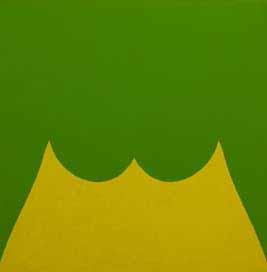27/3/2001
Italian Paintings, 1961-1969
Mamco, Geneve
Retrospective of the American artist Marcia Hafif. After a first exhibition in 1999, Mamco is proud to present Marcia Hafif’s Italian work, Italian Paintings, 1961-1969, with a selection of more than fifty paintings and about a hundred drawings.

Retrospective of the American artist Marcia Hafif.
After a first exhibition in 1999, Mamco is proud to present
Marcia Hafif’s Italian work, Italian Paintings, 1961-1969, with a
selection of more than fifty paintings and about a hundred
drawings.
Leaving California to live in Rome in 1961, M. Hafif took with
her the questions and lessons of the Los Angeles Ferus Gallery
(1957-1966). A space for reflection and exhibition for the young
West Coast and New York art scene founded by Walter Hopps and
Edward Kienholz, the Ferus Gallery showed a varied number of
artists, from Wallace Berman, to Ed Ruscha, Jasper Johns,
Ellsworth Kelly, Andy Wahrol, etc. M. Hafif’s California Type
Drawings bear the trace of the abstract expressionism which she
also encountered at Ferus. They are marked by a symmetry which
originated in a broken wrist, leading her to become ambidextrous
and conditioning her working procedures.
Stimulated by the Italian context she arrived in, M. Hafif worked
in series and multiplied the form/background dualities in
compositions which flirted with figuration, as the
headings-Marble Forms, Games, Advertising, Family, Distance, Open
Center, Burroughs, Hill Shape, Body Parts, English Poetry-show.
These generic formulas however did not appear in the works’
description: their titles are reduced to numbers following the
chronology of the execution. Her formal vocabulary translated
outside chromatic influences 'the geometry and polychromy of
Italian architecture, signs, adverts, design, etc. The
architecture of Lyon was later to have a similar impact on her
monochrome series, French Paintings.
Color, which she definitely chose against the line after her
return to painting in 1972, is applied in luminous and saturated
flat coats. The motif on the canvas, at first centered, then
spreads out to its limits almost reaching the monochrome in
compositions which are increasingly Hard Edge. As the Italian art
critic Marisa Volpi wrote in 1968 : 'Her painting is composed of
two colored parts. As they touch they shape a curved margin. Of
these two parts, which is the space and which is the shape?
Inside this tension of two opposite groups that must balance each
other, Marcia uses her particular talent for using color as a
dynamic element' either absorbing or spilling out, motionless or
aggressive. Through this color-form dynamic, visual perceptions
undergo an interruption highlighted by the subtle play of
repetition with variations 'different dimensions, variatiions of
color and form in different combinations 'and we discover anew
what the act of ‘seeing’ really means.'
Like Matisse’s cut-out gouaches, from 1966 to 1968 M. Hafif also
made series of 'pop' collages using colored vinyl papers where
she cut out a pattern which was then modulated until the
exhaustion of the form, in parallel to the paintings.
The 'pre-history of her evolution towards the monochrome', this
little known and partly never exhibited body of work begs the
question of the iconographic dimension of abstraction and shows
the emergence of anthropomorphic forms in abstract painting in a
combination of lines and chromatic fields marked by the heritage
of Matisse. No disenchanted world here, but an hymn to color and
line. A real retinal pleasure.
The text by Marisa Volpi, translated from the Italian, is
extracted from the catalogue Marcia Hafif, Galleria Il
Sagittario, Bari, mars 1968.
Marcia Hafif was born in 1929 in Pomona, California; she lives in
New York and California.
Mamco is open : daily (except Mondays) from 12h to 18h.
Late openings are on Tuesdays till 21h. No late opening from June
15 to September 15.
Annual closing days : December 24; Good Friday; May 1st; August
1st; and Jeûne genevois: September 7, 2000.
Press Office
Jacques Magnol. Mamco, 10, rue des Vieux Grenadiers. 1205 Genève
Tél. : +41 (0)22 320 61 22 - Mob. +41 (0)78 665 81 79



